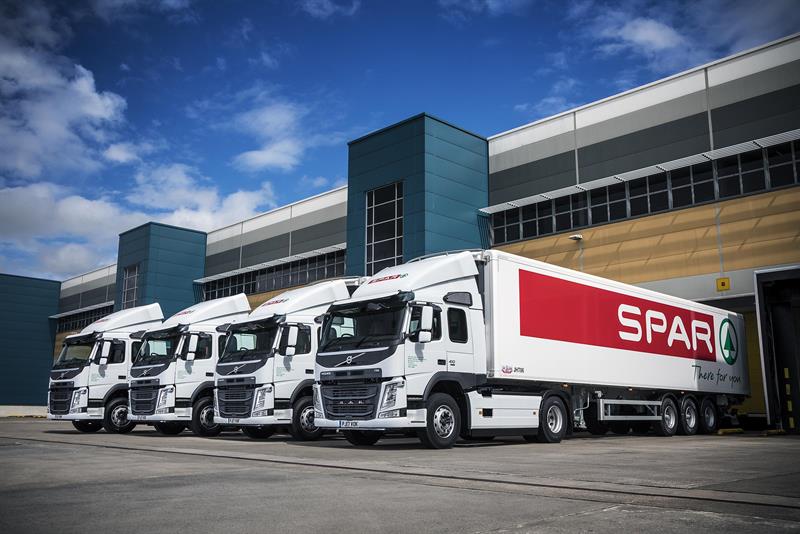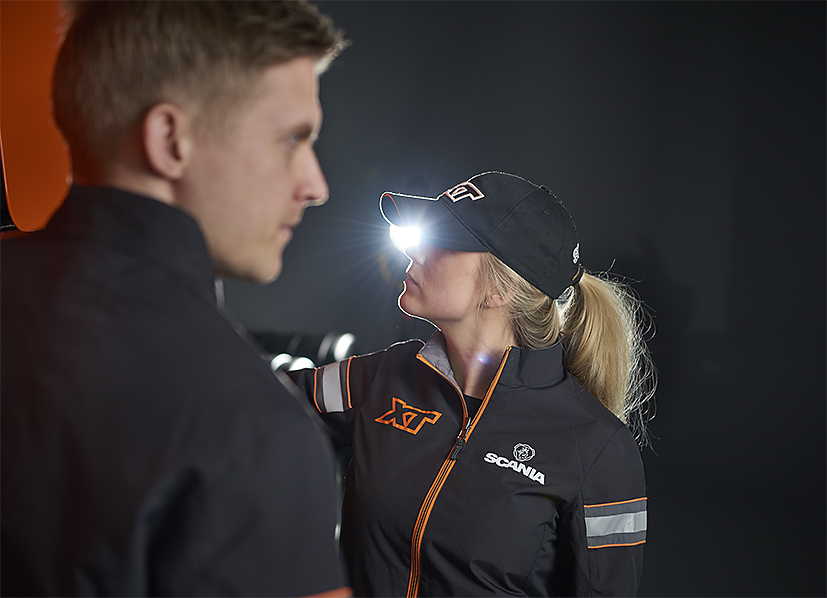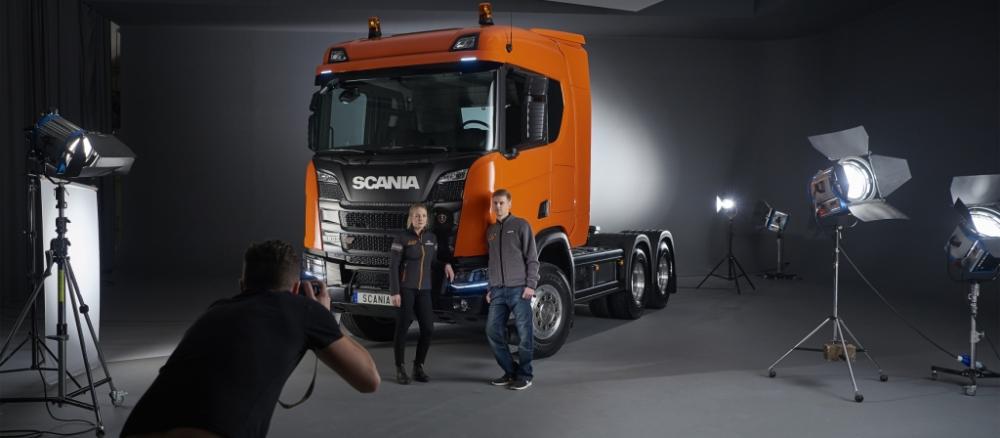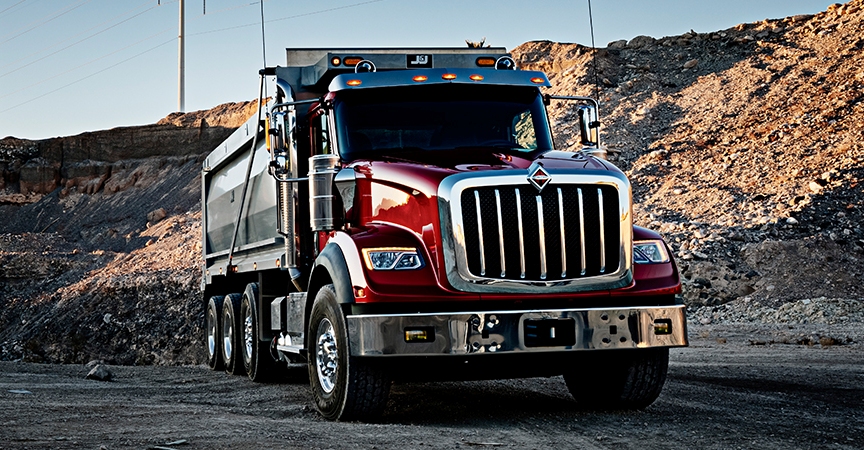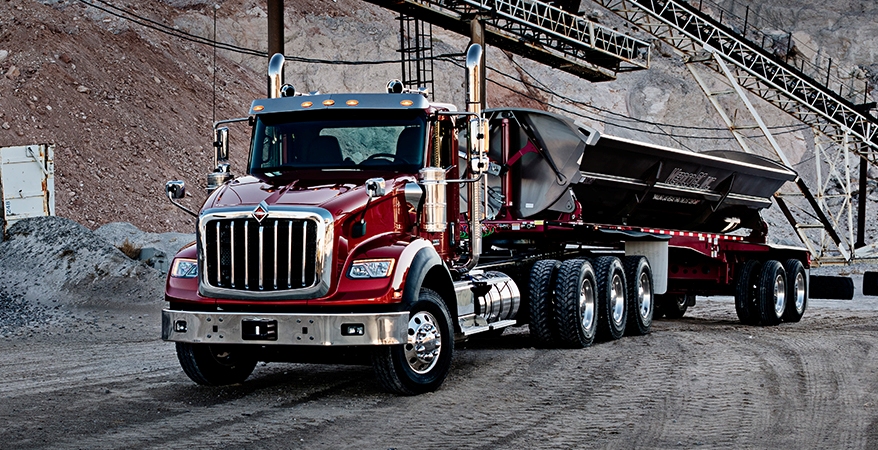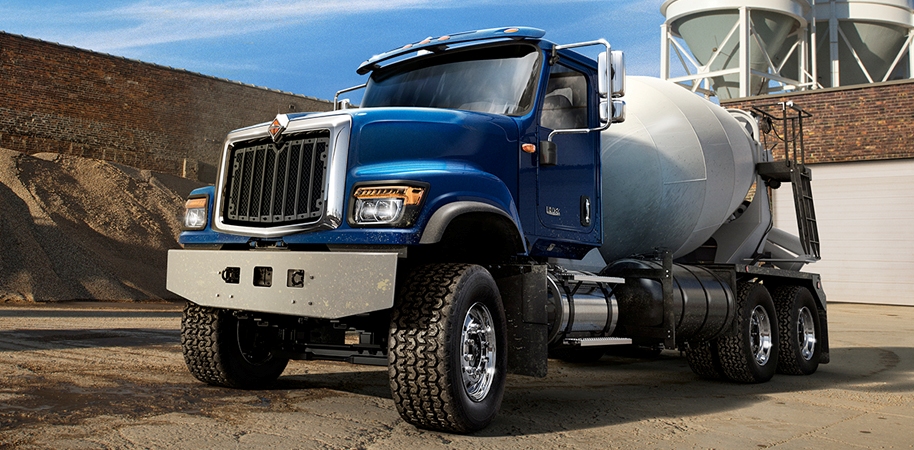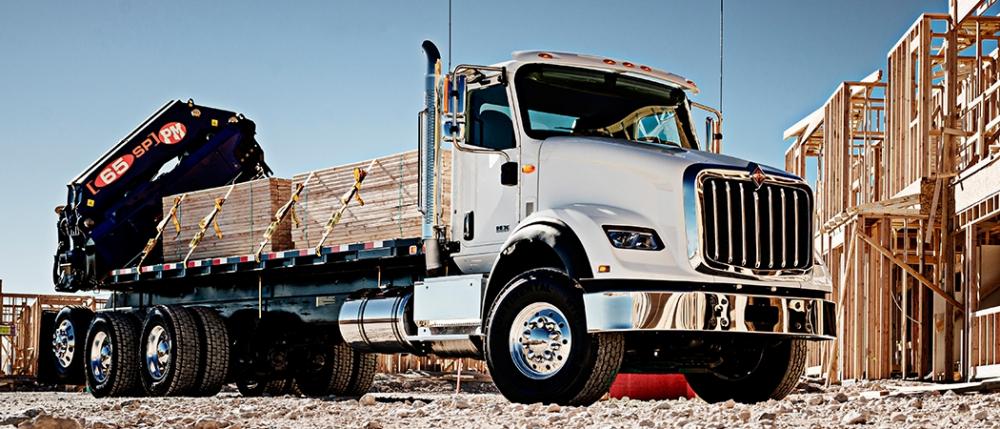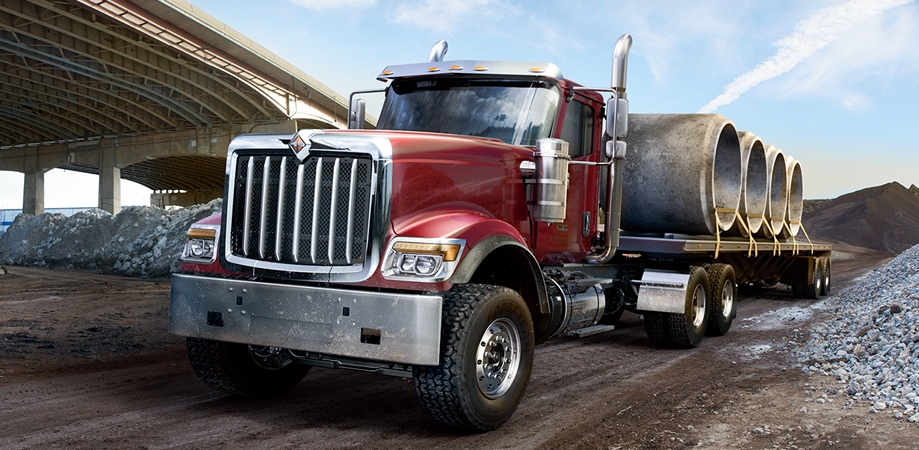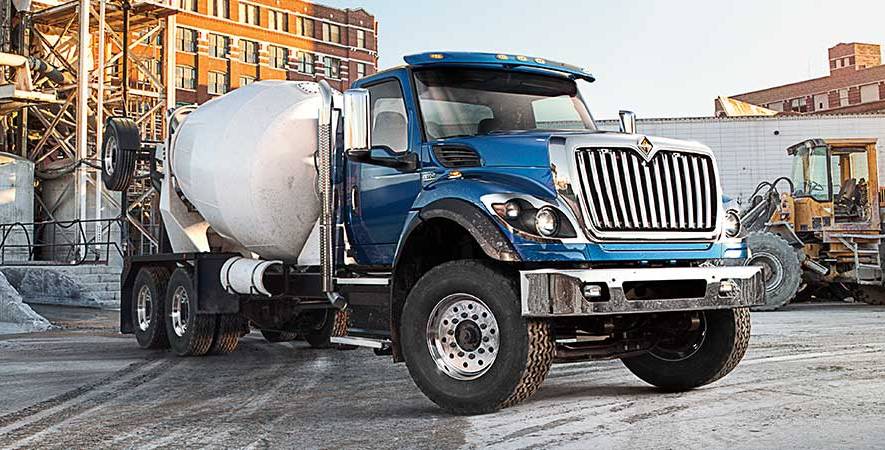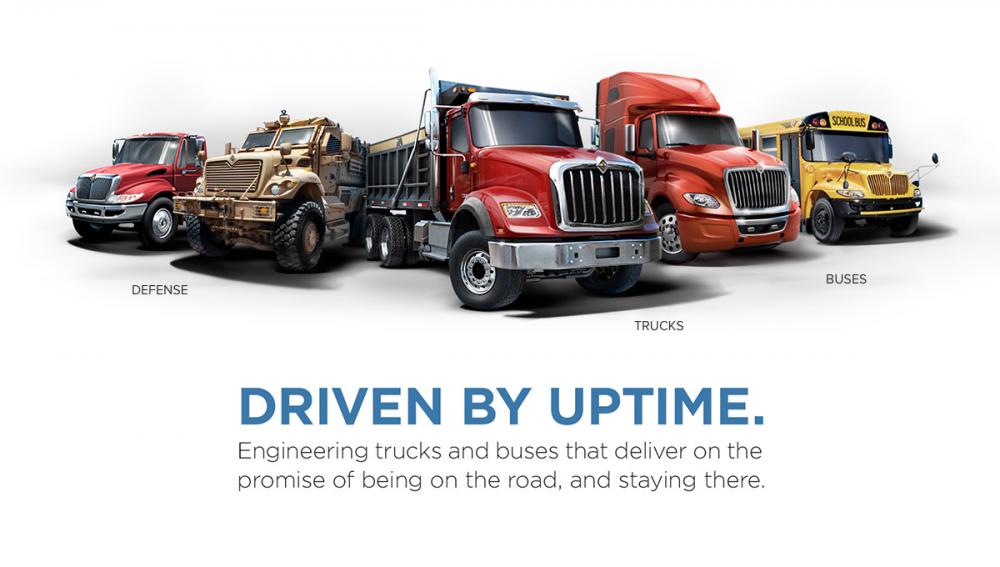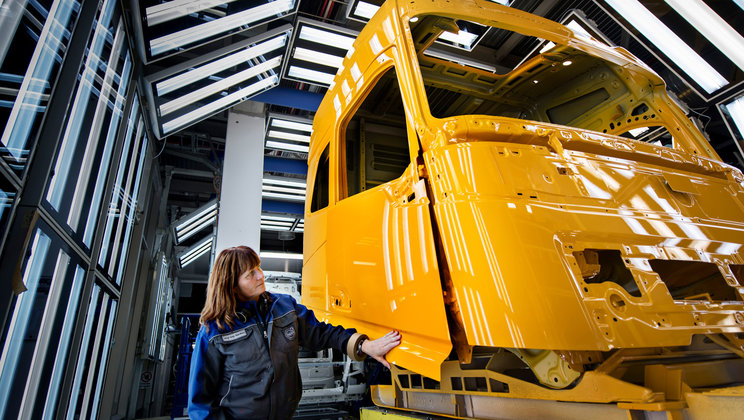
kscarbel2
Moderator-
Posts
18,881 -
Joined
-
Days Won
114
Content Type
Profiles
Forums
Gallery
Events
Blogs
BMT Wiki
Collections
Store
Everything posted by kscarbel2
-
-
Hyundai Commercial Vehicle Press Release / September 12, 2017 .
-
Daimler launches Mitsubishi Fuso eCanter in US market
kscarbel2 replied to kscarbel2's topic in Trucking News
-
Bharat Benz Press Release / September 22, 2017 Five years ago we introduced our first truck in India. To celebrate our anniversary we went on our biggest adventure yet. During our High Five Rally, we traveled 9000 kilometers in 35 days across the country to thank customers, fleet owners, dealers and truck drivers. Watch this video for impressions of our epic journey! Thank you for your trust! .
-
Transport Engineer / September 18, 2017 Spar wholesaler and distributor James Hall & Co has taken delivery of eight new Volvo trucks, six FM 4x2 tractors and two FE 6x2 rigids. Supplied by Thomas Hardie Commercials, the Lancashire-based operator’s new additions will serve 600 Spar stores in the north of England. The trucks all feature the Volvo 11-litre engine, rated at 410bhp in the tractors and 320bhp in the rigids, plus the I-Shift automated transmission. All are on seven-year Volvo Gold R&M contracts with the dealer. Ian Farnworth, fleet engineering manager, says the tractors are ideal for the delivery operation: “The FM has very good low entry which suits a multi-drop operation.” He adds: “Every vehicle we have is potentially operating in a multi-drop environment.” Farnworth says the decision was taken to specify the single-drive three-axle rigids, rather than two-axles, to meet the changing profile of the stores the company delivers to – making it possible for them to accommodate a larger delivery vehicle. The new vehicles join an 86-strong fleet, of which 52 are now Volvo trucks. There is an equal split between artics and rigids, with the artic fleet operating at a maximum gcw of 40 tonnes The operator runs some Gray & Adams 13.6 metre, dual-temperature, double-deck fridge trailers as well as a number of 11.2m dual-temperature spec tandems from the same manufacturer. .
-
Tenneco Supplying Diesel Aftertreatment for Daimler Trucks 2018 Medium-Duty Engine Platform Tenneco Press Release / September 25, 2017 ATLANTA—Tenneco announced today at the North American Commercial Vehicle (NACV) truck show in Atlanta that it will supply full aftertreatment systems for new Detroit DD5 and DD8 medium-duty engines. The four and six cylinder engines were developed to meet and exceed the rigorous demands of different global markets while complying with current and future emissions regulations. Tenneco will supply the full aftertreatment system, which includes the complete selective catalytic reduction system featuring the company’s proprietary mixing technology, as well as muffler and pipes. The system will be available in multiple understep, side-by-side and horizontal variations designed to accommodate the Daimler Trucks product portfolio, which includes Mercedes-Benz trucks and buses, Setra, Freightliner, Freightliner Custom Chassis, BharatBenz, FUSO, and Thomas Built Buses. “We are pleased to partner with Daimler Trucks to support the important launch of their global engine platform for medium-duty trucks,” said Brian Kesseler, chief executive officer, Tenneco. “This platform demonstrates Tenneco’s commitment to provide commercial truck customers with our most advanced aftertreatment solutions that meet the needs of the evolving global regulatory landscape, while enabling greater fuel economy and reduced CO2 emissions.” The aftertreatment system was designed and engineered at Tenneco’s technical center in Edenkoben, Germany, and will be manufactured and assembled at the company’s Clean Air facility in Seward, Nebraska. Tenneco is a global supplier to Daimler, providing both Ride Performance and Clean Air technologies on many light vehicle platforms globally in addition to commercial truck solutions.
-
Hendrickson 6x2 Liftable Forward Tandem Axle Available on Cascadia
kscarbel2 replied to kscarbel2's topic in Trucking News
Hendrickson Partners with Freightliner Trucks on 6x2 Liftable Forward Tandem Axle Hendrickson Press Release / September 25, 2017 ATLANTA, Georgia — Hendrickson Truck Commercial Vehicle Systems announced today at the North American Commercial Vehicle (NACV) Show they partnered with Freightliner Trucks to offer the OPTIMAAX 6x2 liftable forward tandem axle, exclusive to the new Cascadia. The new OPTIMAAX reduces weight, saves fuel and improves traction and maneuverability. The new OPTIMAAX axle will help fleet customers optimize the movement of variable loads, as well as assisting carriers with diminishing loads, such as bulk haulers and delivery vehicles that may have empty back hauls after carrying items such as groceries, livestock, beverages and fuel. It will also help fleets that focus on weight reduction and those who want to optimize fuel efficiency. Automated controls sense the load capacity and either lift or lower the axle without relying on the driver, maximizing time with a raised axle and enhancing traction. The benefits: · Boosting fuel efficiency · Reducing weight by 300 to 400 pounds over a comparable 6x4, allowing trucks to either carry additional weight or save fuel · Gaining traction when backing under trailers in soft soil or low traction conditions · Improving maneuverability when the lift axle is raised · Saving money on tolls where lift axles are not charged if lifted “This combines a leader in heavy trucks with a leader in suspension technology,” said Gerry Remus – General Manager Sales and Business Development for Hendrickson Truck Commercial Vehicle Systems. “It’s one more way we’re focused on engineering our product for efficiency, and are lowering the overall running costs for fleets,” added Remus. The OPTIMAAX 6x2 design is compatible with drum and air disc brakes, and it’s unique because the axle is fully welded, not bolted. That gives it additional strength and durability. -
Scania Press Release / September 25 2017 XT, Scania’s new range of trucks and solutions suited for the toughest operations, signals robustness. So does the clothes collection that’s coming with it. The new XT clothes collection celebrates the launch of Scania’s new range of trucks for the toughest challenges – and honours the construction drivers who will drive them. “These are the men and women who make the wheels spin when things get really rough,” says Sophie Haftor, Director Vehicle Accessories and Branding Products. Everything added to the new truck range has its function and is thought about from the user’s point of view. The same goes for the clothes. “It’s been fantastic to work with a completely new range within Scania,” says Susanna B Hansson, Product Manager for Scania Truck Gear. “It´s almost like a new V8 to us.” In the construction industry it’s all about heavy work. The XT clothes collection shows and supports the strength and power in the new Scania vehicles developed and designed for these tough operations. “Also, it has been great fun to work with new colours,” Hansson says. “In our standard Truck Gear collection, colours are more down to earth. Here, the XT Orange really stands out.” .
-
Daimler AG Press Release / September 25, 2017 Heroes don’t just exist on the silver screen. They live among us. Every day they get up before sunrise to keep our economy running. Every day they are willing to sacrifice time with their families to make our modern lives possible. And they do it with dedication, love and pride. Because they know that they are part of something bigger than themselves. We often don’t think about the work they do, but we can always rely on them to get the job done. These are the everyday heroes who keep the world moving. .
-
Navistar Press Release / September 25, 2017 - International® HX™ Series available with integrated 51" sleeper cab - Will be available with the International® A26 12.4L big bore engine ATLANTA -- International Truck today unveiled its most recent product expansion to its vocational truck portfolio at the inaugural North American Commercial Vehicle Show. Expanding the Class 8 premium vocational truck line-up, the International® HX™ Series is now available in a 51 inch sleeper cab on both the HX520 and HX620 models. The International® A26 engine, a powerful 12.4L engine designed to provide industry-leading uptime will be available in both the HX Series and the all new International® HV™ Series. "We're thrilled to bring even more options to the vocational truck market with products that are redefining the standard for uptime and productivity," said Michael Cancelliere, president, Truck and Parts. "With the introduction of the International A26 engine on our off-highway products, we continue to raise the bar for vocational and severe-service vehicles by including our big bore engine that will reliably provide our customers with the power and versatility to meet any application." Offering optimal maneuverability and excellent forward visibility designed with the industry's only dedicated vocational lightweight aluminum cab, available 3.5 million RBM 0.5" huck-bolted single rail frame, and set-forward front axle built to tackle stringent axle weight restrictions, the HX Series more than delivers. Plus, premium features such as an all-metal grille, available dual external chromed air cleaners and halogen headlamps with LED daytime running lights conveys strength and professionalism moving its driver to the head of the class. "In our pursuit to be the leader in putting the driver first in all of our truck design and product offerings, we listened to our customers and their desire to have a sleeper option in the HX Series, a premium Class 8 vocational truck," said Mark Stasell, vice president, Vocational Truck Group. "The HX520 and HX620 models will be available with an integrated 51" short sleeper cab for those drivers that need an incredibly rugged chassis designed to survive in punishing off-road applications and require a comfortable work space and roomy place to rest after a demanding day behind the wheel." The HX Series addresses a full range of applications for the severe service industry. The trucks were engineered to withstand the most punishing job sites and include prime features such as a 40 degree wheel cut with 425 series tires for improved maneuverability and an all-new standard cab air suspension for a supremely comfortable ride. The HX Series is purpose-built to deliver Uptime in every aspect of its productivity, efficiency, reliability and performance. "We're excited to offer our customers the International A26 engine, designed with uptime in its DNA, on the HX Series and across our vocational truck line-up," said Stasell. "Much like our Class 8 on-highway customers, they will experience a quieter ride, better fuel economy, and excellent corrosion prevention due to significant enhancements built into the engine. The A26 will include vocational ratings on the HX Series that will deliver application specific torque and power for any job site while giving drivers maximum comfort from a quieter ride." The HX515 and HX615 are powered by the International A26, a 12.4L engine, designed to provide industry-leading uptime, greater fuel efficiency, and quieter operation. Built from the proven MAN D26 engine crankcase, the A26 produces up to 475 horsepower and 1,700 lb.-ft. of torque from a design that is 600-700 lbs. lighter than a traditional 15L big bore engine. The A26 is also backed by the industry's best warranty and is the first engine to meet the B10 standard that requires 90% of delivered engines to travel 1,200,000 miles before a major repair. Four HX Series models are offered, with both set-forward and set-back front axle models in either short or long hood, depending on the application. The HX515 is a 114" BBC Set-forward Axle Straight Truck with primary vocations including concrete mixer, construction dump, refuse/roll-off and crane. The HX615 is a 115" BBC Set-back Axle Truck or Tractor with primary vocations including construction dump, concrete mixer, platform stake/crane and refuse/roll-off. The HX520, is a 120" BBC Set-forward Axle Truck or Tractor with primary vocations including heavy haul tractor, construction dump and platform stake/crane. The HX620 is a 119" BBC Set-back Axle Truck or Tractor with primary vocations including heavy haul tractor, construction dump and platform stake/crane. 51" Short Sleeper Cab will be available on the HX520 and HX620 models. The HX515 and the HX615 models are powered by International A26 engines, while the HX520 and HX620 models offer the Cummins® X15 engine. For more information on the HX Series or to locate a dealer, visit: InternationalTrucks.com/HXSeries. Visit International at Booth 4020 at the North American Commercial Vehicle Show 2017. .
-
International Truck Launches The New International HV Series At The North American Commercial Vehicle Show Navistar Press Release / September 25, 2017 - HV Series is a smart truck designed for serious work, brawn and brains - First severe service vehicle launched with the International® A26 big bore engine - Combines significant uptime enhancements with DriverFirst™ features and advanced integration options for body builders ATLANTA -- International Truck today launched the International® HV™ Series at the inaugural North American Commercial Vehicle Show. HV Series is the first severe service truck available with the International® A26 12.4L big bore engine and designed to deliver power, refined driver-features, and impressive reliability for a range of vocational applications. "The new International HV Series is just one more truck in our product lineup that puts drivers first and meets the grueling demands of vocational applications," said Michael Cancelliere, president, Truck and Parts. "The HV Series is a smart solution for our customers in the business of doing serious work and is a new breed of vocational truck that redefines the standard for uptime and productivity. It is the go-to truck for those who know that it's not just about getting the job done, it is about getting it done right." Redesigned from the inside out, the HV Series interior was crafted with driver and body company feedback to ensure the most comfortable and productive environment possible, while the exterior continues with powerful styling. The HV Series also features the intelligence of the industry-leading Diamond Logic® electrical system for the automation of tasks and interlocks to help protect both equipment and crew. The truck offers customers an incredibly versatile foundation for any configuration necessary to be productive at any job and includes power options like the International A26, an engine designed with uptime in its DNA. "Customers and Truck Equipment Manufacturers (TEMs) have given us feedback during the design process and, as a result, we have made the highly versatile, rugged and reliable HV Series easy to integrate body solutions seamlessly," said Denny Mooney, senior vice president, Global Product Development. "We've been building vocational trucks for over a century and in the HV Series our engineers have successfully incorporated driver feedback into a severe service truck designed to be easily configurable for any application." The new HV Series is another signal to the industry that International Truck is focused on uptime and delivering the best trucks in the industry that drivers want to drive. Brawn and Brains that Never Quit, Taking Uptime to a Whole New Level The HV Series was designed with intelligent features and the goal of best-in-class uptime all packaged into a truck that offers brute strength. For example: Heavy duty, double-sided galvanized steel cab for long-term durability. Huck bolt chassis fasteners provide superior clamping force and will not come loose even in extreme environments. Also available with a clean Cab-to-Axle (CA) configuration to minimize costly post-production modifications. 20,000 lb. off-set bowl front drive axle allows for a lower ride height than a traditional center bowl. Super Single ½" thick fame rail rated up to 3.35M RBM. Integral 20" and 27" frame extensions (not bolt-on) for superior strength and reliability. Available stainless-steel oil pan for reduced corrosion in highly corrosive applications. New industry-standard J1939 electrical system architecture and improved harnessing to maximize uptime. All new best-in-class HVAC system, designed for reliability, now includes a high-performance MAX defrost feature. The HV Series is powered by the International A26, a 12.4L engine, designed to provide industry-leading uptime, greater fuel efficiency, and quieter operation. Built from the proven MAN D26 engine crankcase, the A26 produces up to 475 horsepower and 1,700 lb.-ft. of torque from a design that is 600-700 lbs. lighter than a traditional 15L big bore engine. The A26 is also backed by the industry's best warranty and is the first engine to meet the B10 standard that requires 90% of delivered engines to travel 1,200,000 miles before a major repair. HV Series is also available with the Cummins® B6.7 and Cummins L9 engines. The HV Series was engineered to make it easier to get maintenance and get back on the road fast. And when service is needed, count on an International dealer with expert technicians and an extensive parts inventory wherever a driver may be throughout North America. Every HV Series can be equipped as an option with OnCommand® Connection, the company's leading-edge remote diagnostics system and Over-the-air (OTA) programming. OTA, available through the nine-pin International® LINK device, enables drivers or fleet managers to utilize a mobile interface to initiate authorized engine programming at the customer's facility over a safe, secure Wi-Fi Connection. The service offers drivers and fleets an easy, secure means of updating engine control modules to reflect the latest manufacturer-approved calibrations, without the necessity of visiting a dealer or other service facility. Diamond Logic Provides Seamless Integration for Truck Equipment Manufactures The International HV Series provides the ideal foundation for an almost unlimited number of applications. Customers can order the specific chassis configuration needed for any application upfront which substantially reduces the time and expense involved to up fit the vehicle in post-production. To further improve driver productivity and safety, the HV Series features the best-in-class Diamond Logic, an advanced electrical system that streamlines chassis and body equipment integration and allows customers to program automated tasks. "Our Diamond Logic electrical system is best known for its ability to provide control and communication between work trucks and body equipment," said Mark Stasell, vice president, Vocational Truck Business. "We are a pioneer in custom programmable chassis electronics and multiplexing and we continue to partner with end users and body builders to further increase productivity and make it easy to integrate with our system." Equipped with the Diamond Logic electrical system, the HV Series will get the job done with both safety and precision by offering vocational customers nearly 200 factory available body integration and driver efficiency features, plus the ability to customize infinitely more vehicle functions. Best-in-Class Driver Features "In many ways we've designed the new HV Series from the inside out based on our DriverFirst philosophy," said Stasell. "Based on customer feedback during the planning and design process, our engineers succeeded in making the HV Series one of the most comfortable, reliable and safe vehicles to operate in any work environment and in any climate." DriverFirst enhancements that contribute to productivity, include: Redesigned cab doors with a lower bottom glass edge and removed the vent window giving the driver a single large piece of glass to look through, greatly improving side visibility and reducing blind spots. By reshaping the doors and side glass, the position of the optional pedestal mirrors was optimized so drivers turn their heads 15% less on the left side and 5% less on the passenger side, making it easier to keep their eyes on the road while reducing neck strain over the long haul. An all-new dash designed for the driver with more space for additional rocker switches. An available premium gauge cluster designed with driver input that is customizable with virtual gauges. An easy-access column-mounted stalk shifter integrated with engine braking to help keep hands on the wheel and eyes on the road. Introduced the 'wing panel' dash' tailored for the vocational truck and driver. The new stalk shifter placement and the lower instrument panel design greatly improve leg room for the driver, especially at the knee. An additional vent has been added to help keep the middle front passenger comfortable. The dash contains space for up to 30 customizable switches ensuring functionality of any type of body that is mounted on the back. Switches offer large easy to read text and recognizable ISO symbols and are back lit for easy viewing at night and offer seven unique color options for the indicator lights. For complex body applications like ambulance, fire or high-railers, the multi-color lights allow for a higher level of customization and functionality. A new fuse panel is much easier to service with no exposed wires. The panel has a new spill proof design allowing liquids to flow into a gutter around the panel and drain to the outside of the vehicle without damaging any electronics. With an inside wheel cut of up to 50 degrees, the HV Series can easily navigate tight city streets or construction sites, saving driver time, reducing work-site collisions and boosting productivity. The HV Series is available in a variety of specifications: Regular Cab, Extended Cab, and Crew Cab. The company is taking orders today and market availability is March 2018. For more information visit https://www.internationaltrucks.com/HVSeries. .
-
Navistar Press Release / September 25, 2017 - Pursuing a medium-duty vehicle electric powertrain for launch as early as 2019 - Collaborating on fully integrated, next-generation Big Bore powertrains - Exploring common hardware for OnCommand® Connection and RIO brands - Delivering expected synergies with procurement joint venture ATLANTA -- Navistar International Corporation (NYSE: NAV) today announced it expects a number of new product offerings and integrations with alliance partner Volkswagen Truck & Bus, including plans to develop an electric-powered, medium-duty vehicle for the company's Core (U.S. and Canada) market. "Our alliance with Volkswagen Truck & Bus is allowing us to move much more quickly into electric propulsion thanks to our ability to leverage their technology investments and components in segments of the market where we're already a leader," said Troy A. Clarke, chairman, president and chief executive officer, Navistar. "We believe the Class 6/7 vehicle is ideal for electric powertrain solutions in the near term, given its abundance of packaging space, and that these vehicles typically run short distances and can depot to recharge at the end of the day." Navistar expects to be in a position to launch its first medium-duty electric powered vehicle in late 2019 or early 2020. In preparation for the next greenhouse gas emission regulations globally, the maker of International® Trucks and IC Buses also confirmed that it is collaborating with its alliance partner on introducing fully integrated, next-generation diesel big bore powertrains for North America launching in 2021. Navistar and Volkswagen Truck & Bus also announced their intention to converge their connectivity activities – OnCommand® Connection and RIO, Volkswagen Truck & Bus's digital brand – to a Volkswagen Truck & Bus global connected vehicle platform. The first step will be the adoption of common, in-cab connecting device hardware. This would serve as a major step toward creating a global connected platform - covering roughly 650,000 vehicles worldwide, "making it the world's largest global ecosystem for commercial vehicles, once the migration is completed," Clarke said. Volkswagen Truck & Bus expects to launch the cloud-based, brand-independent platform by the end of the year, which will be the basis for the cooperation. "Future transportation will massively be building on connectivity as this will make our world much more efficient," said Andreas Renschler, CEO of Volkswagen Truck & Bus. "The ecosystem we are about to create with our common platform will drive our strategic alliance to the next level." Navistar also reported that the procurement joint venture – Global Truck & Bus Procurement LLC – it created with Volkswagen Truck & Bus is off to a strong start. The team has met with more than 250 new and existing suppliers, and to date, have completed 40 joint bidding contracts. "We're on track to achieve our expected cost savings thanks to our fast start with the procurement JV and the great progress on our technology collaboration," said Clarke. "As a result, we are in a much more competitive position today in the areas that are quickly revolutionizing our industry globally."
-
Navistar Press Release / September 24, 2017 - Showcases complete redesign of Class 8 product line-up, International® HV™ Series - Announces expansion of uptime-focused International® A26 engine in the Severe Service Segment - Features expanded OnCommand® Connection product portfolio, including telematics and electronic driver log - Exhibits gasoline-powered prototype IC Bus CE Series ATLANTA -- Navistar announced that it will usher in a new era of Uptime through the industry's newest product line-up at the inaugural North American Commercial Vehicle Show (NACV). "Navistar and International Truck are better than ever. We've made strategic investments throughout the entire company, and none are more strategic than our completely new lineup of products that are delivering industry-leading uptime," said Michael Cancelliere, president, Truck and Parts. "Our products offer our customers efficient solutions in any class of commercial vehicle and for any application with advanced technologies that support improved driver safety, productivity, fuel efficiency and minimize total cost of ownership. We are a fundamentally different company that is moving forward and taking uptime to a whole new level." At the heart of the company's display, the International® Truck brand will showcase a redesigned Class 8 line-up, including its on-highway and vocational products. The newest vehicle will be announced on Monday afternoon, September 25. Uptime through DriverFirst As part of the company's Uptime mission, International introduced the DriverFirst product design philosophy over a year ago to build on International's long-standing emphasis on customer uptime by sharpening the company's focus on the driver's point of view. Drivers are looking for something comfortable and functional, with a design that helps them do their job better. Drivers that are happy behind the wheel of their truck will be safer and more productive. International Truck listened to and implemented feedback from more than 800 drivers in the development of its recently introduced product portfolio. Products in the booth that demonstrate Uptime through DriverFirst: HV Series vehicle designed with power, refined DriverFirst features, and the versatility to meet the most demanding vocational applications. International® LoneStar®, recently updated, combines bold styling and best-in-class driver features with a number of uptime and safety enhancements. International® LT™ Series debuted in October 2016 is the company's flagship line of Class 8 over-the-road trucks developed through driver centric design and featuring advanced technologies that deliver unrivaled fuel efficiency, best-in-class uptime and outstanding driver satisfaction. International® RH™ Series, announced in April 2017, is a new Class 8 regional haul tractor powered by the new International A26 12.4L engine and designed to deliver best-in-class uptime, improved visibility, and outstanding fuel economy. International® HX™ Series unveiled in February 2016 is a Class 8 premium vocational truck designed to deliver the strength and endurance required for the severe service industry. Focusing on Fuel Efficiency Advancements The LT Series features dramatically improved aerodynamics and provides fuel efficiency that is seven percent better than the company's most recent fuel economy leader, a 2017 ProStar® with the Cummins® ISX15 engine. The LT Series with the International® A26 engine can achieve nine percent better fuel economy than the previous 2016 model engine paired with a ProStar. International has always placed a strong emphasis on industry-leading aerodynamics as a solid foundation for fuel efficiency, and the CatalIST (International SuperTruck) delivers high-tech advancements already finding their way into production vehicles. CatalIST achieved a freight efficiency improvement of 104 percent compared to the control vehicle, exceeding the improvement goal set by the U.S. Department of Energy for the SuperTruck program. Products in the booth that demonstrate fuel efficiency: International® LT™ Series with the International® A26 engine, launched earlier this year, is a powerful new 12.4-liter engine designed to provide industry-leading uptime to the Class 8 market. Driven by a commitment to deliver customer uptime, the A26 was developed through an initiative called Project Alpha, which brought together a new team of the industry's foremost powertrain engineers. The initiative pursued a fresh approach using proven components to deliver industry-leading uptime. CatalIST (International SuperTruck) is an innovative SuperTruck demonstration vehicle that is driving innovations achieved from the program into future commercial vehicles. Enabling Uptime through New Engine Design, Connectivity International continues to lead in uptime through new engine design and leveraging the power of connected services. The International A26 was designed from the ground up to deliver industry-leading uptime, durability and reliability. It is an engine with uptime built into every part of the development process, from design to calibration to testing. Navistar has invested significantly in telematics solutions and will continue to invest in new products that improve vehicle uptime and customer relationships. OnCommand Connection Telematics Solution is the industry's only open architecture remote diagnostics system supporting more than 325,000 vehicles of all makes and models. OnCommand Connection Telematics and OnCommand Connection Advanced Remote Diagnostics are integrated with OnCommand Connection Electronic Driver Log (EDL), which automates federal Hours of Service compliance requirements that are mandated for all heavy duty trucks by December 18, 2017. The industry's largest dealer network provides Navistar with the foundation required to execute on the promise to be the leader in Uptime. Our OnCommand Connection solutions combined with the Uptime Command Center are the backbone of International's commitment to deliver industry best uptime. Engines and connectivity solutions in the booth that enable uptime: International® A26 Engine OnCommand Connection Interactive Experience featuring: OnCommand Connection Telematics, OnCommand Connection Advanced Remote Diagnostics, OnCommand Connection Electronic Driver Log. Looking to the Future IC Bus is committed to lead, innovate and revolutionize the bus industry as a leading manufacturer of school buses. IC Bus applies the highest quality standards to deliver the best buses on the road and provides customers with a wide array of powertrain options to meet specific bus needs of customers. IC Bus engineers are developing the next generation powertrains for the bus of the future. The alliance between Navistar and Volkswagen Truck and Bus is allowing both companies to move quickly toward leveraging technology investments and components. The companies are tracking well to the initial plan and cost savings estimates and together both companies are working on 13 major projects and have identified even more areas for collaboration. Together, Navistar and Volkswagen Truck & Bus expect significant synergies from both the strategic technology and supply collaboration and the procurement joint venture. Areas of the booth that demonstrate future technologies: IC Bus Gasoline-Powered CE School Bus designed to make ownership more affordable and to provide easier maintenance for school districts and contractors. Volkswagen Truck & Bus Alliance The entire International Truck product portfolio—from heavy-duty on-highway tractors to medium-duty and severe service vocational trucks—will be on display at the North American Commercial Vehicles Show. Visit International Truck Booth 4042 to see International's product offerings or visit www.internationaltrucks.com. .
-
Volvo Group Press Release / September 25, 2017 Volvo Trucks’ customers have a choice of 800 colours for their truck cabs. If their favourite colour is missing, the paint lab at Volvo Group Cab plant in Umeå, Sweden can usually find a solution. Winter White is still one of the most popular colours for Volvo trucks, but an increasing number of the 300 or so trucks that leave the plant in Umeå every day are painted in different colours. “There have recently been a large number of different colours and we are seeing more and more metallic and clear varnish. Metallic is my personal favourite. There’s a blue variant which is extremely attractive,” says, Quality Control Operator, Yvonne Määttä. Before the cab is checked at the inspection station, it has to pass through a wide range of stages. After being dipped in the corrosion protection paint, primer is applied to the cab before the time comes for the robots to spray on the topcoat. The paint is then left to harden for 45 minutes in a large oven. Even if the actual painting process is fully automated, many different people and functions are involved in working on colours. Some of them work at the paint lab, one floor up at the plant. Among other things, new colours are developed at the lab and this is where customer requests also end up. Because, even though Volvo Trucks offers its customers no fewer than 800 different variants, new requests and wishes are received every week. “We have, for example, received samples on a piece of fabric, mobile phone shell or nail polish. In most cases, we are able to offer customers colours that are very close to the ones they want or else we can develop a totally new colour. Only in very rare cases are we forced to say no. That’s when the colour doesn’t have the necessary properties,” explains Andreas Bask, Paint Lab Manager. Before a new colour is introduced into production, it is subjected to rigorous tests and checks. Volvo Trucks’ customers set rigorous requirements for their trucks and every step in the painting process is important in order to ensure quality and make sure that the customer is given the precise colour he or she has specified. “We conduct a close dialogue with all the functions that are involved in the process. Even if we all have different focal points, everyone is aiming for the same thing – to ensure that the end result is as good as it can possibly be. Volvo Trucks is a premium brand and customers expect the paint to last for a very long time,” says Andreas Bask. The Volvo Group cab plant in Umeå has also invested heavily in improving both the internal and external environment. With advanced cleaning technology for air, new solvent-free materials and modern painting equipment, the plant is currently one of the world’s cleanest paintshop within the automotive industry. Facts The Volvo Cab Competence Center is located at the plant in Umeå. This means that the plant provides support for the development of new product concepts for cabs, as well as innovative and profitable production technologies within stamping, assembly and surface treatment. Umeå is also the introductory plant for new technologies and materials. It supports other plants in the Volvo Group with know-how and technical support when it comes to matters related to processes and product issues related to manufacturing. .
-
Volvo Group Press Release / September 22, 2017 Together with her husband, Huguette Durand has built a distrubtion company on a passion for vehicles and driving. One hundred per cent of the fleet is made up of Renault Trucks. Huguette Durand caught the trucking bug when she started driving trucks as a 22-year-old. “A chance internship pushed me into the world of trucks,” she says. “And then, I never left.” She started a transport company together with her sister, which some years later merged with her husband’s. Today the company, Transports Durand-Lemi, has 14 drivers, including the owners’ eldest daughter. They primarily carry non-hazardous chemicals. “At Durand-Lemi, we are truck drivers first and foremost. When we buy a truck, we buy for comfort and safety and the prestige to make our customers proud. The purchase is also a question of environmental performance,” says Huguette Durand. For her, this translates into buying only from Renault Trucks. “My husband, Christian, is a big fan of the brand,” says Huguette Durand, who actually first started driving Mercedes but converted after trying a Renault Magnum. “With their elevated cabins, they were tricky to manoeuvre, but they were also so much more spacious and comfortable for the driver.” Today, Transports Durand-Lemi owns 15 vehicles, the last of which is a deep-black T Range enhanced with a vermillion red trim. The truck was a birthday surprise from her husband, Christian, which was unveiled at the inauguration of the Renault Trucks workshop in Saint-Egrève last November. Celebrating birthdays together is a clear sign of a special relationship and Huguette Durand describes the dealership as a “very trusted partner”. But she has also been happily surprised by Renault Trucks’ service network on occasions when trucks break down far from home. Service has always been provided in a very responsive and personalised manner. Knowing this makes it easy to relax and enjoy the driving, which Huguette Durand has now resumed in her new truck. “It is such a pleasure to be behind the wheel again, so now I drive between Lyon and Hanover every week – it’s a real joy.” .
-
Reuters / September 26, 2017 DETROIT - Commercial truck partners Navistar International Corp and Volkswagen AG’s (VOWG_p.DE) Truck and Bus said on Monday they will launch an electric medium-duty truck in North America by late 2019, and develop common hardware and systems to connect trucks to the internet. Volkswagen Truck Chief Andreas Renschler and Navistar Chief Executive Troy Clarke told Reuters in an interview the companies will also collaborate on the next generation of “Big Bore” diesel powertrains. Volkswagen last year agreed to buy a 16.6 percent stake in Navistar, based in Lisle, Ill. The companies closed the transaction and began collaborating earlier this year. The companies are on track for projected cost savings of $500 million over the first five years of the alliance, Clarke said in a statement. Commercial truck makers are investing in electrification as regulators and policy makers have stepped up pressure to curtail or eliminate pollution from diesel engines in big cities. Navistar shares were trading about 1 percent higher in afternoon trading on the New York Stock Exchange. The new electric truck for North America will be a Class 6 or 7 truck based on a Navistar vehicle, and aimed at urban delivery customers. Volkswagen will test nine electric trucks in Austria that will offer payloads of about 18 tons and ranges of about 180 kilometers between charges, Renschler said. Rival Daimler AG said last week delivered the first of a smaller range of electric delivery trucks to customers in New York. The challenge for vehicle makers is to produce electric trucks that deliver competitive payload capacity and range at a cost that matches or beats the cost of diesel-powered vehicles. “Ours is an industry where technology adoption is very deliberate,” Clarke said. However, if cities do ban diesel trucks, “we have an offer,” Renschler said. Renschler and Clarke said joint development of common hardware and software for connecting trucks to the internet, and of next-generation large diesel engines, could slash the companies’ costs. Volkswagen plans to launch a cloud-based connectivity platform by the end of the year that will not be tied to a specific vehicle brand, and that will be the basis for the shared system. The companies plan to ultimately connect 650,000 vehicles, and create a common marketplace for app developers, the companies said.
-
OnCommand Connection International Trucks Press Release / September 25, 2017 .
-
International Trucks Press Release / September 25, 2017 .
-
DTNA Family at North American Commercial Vehicle Show
kscarbel2 replied to kscarbel2's topic in Trucking News
“Let’s Connect” live at North American Commercial Vehicle Show Daimler Trucks North America (DTNA) Press Release / September 25, 2017 See how we’re driving the industry with an overview of our latest and greatest engineering innovations. . -
Daimler Trucks North America (DTNA) Press Release / September 25, 2017 We brought the whole family to NACV. .
-
Cummins seeks to capitalize on future trucking trends
kscarbel2 replied to kscarbel2's topic in Trucking News
Cummins engine boss vows to offer customers “power of choice” James Menzies, Truck News / September 24, 2017 ATLANTA, Ga. – Cummins is uniquely positioned to offer customers their “power of choice” well into the future, according to president of the engine business, Srikanth Padmanabhan. Padmanabhan was speaking to truck press today at the inaugural North American Commercial Vehicle Show, where he said Cummins will be able to provide internal combustion engines, as well as full-electric and hybrid powertrains, and eventually even fuel cell electric powertrains. “We have shown time and again, when the industry changes, or when technology changes, that is when we deliver and when we deliver for our customers in a big way,” Padmanabhan said. “We will be there to provide that power of choice for our customers, regardless of what the powertrain is going to be.” He cited Cummins’ history of “technological leadership,” including its introduction of the diesel engine when trucks were predominantly powered by big gasoline engines. Cummins has been in the engine business for 100 years and will this year produce 1.3 million engines. It has a running population of 15 million engines. The next 15 years, said Padmanabhan, will see further disruption, in the form of connectivity, automation, and energy diversity. He said Cummins will play a role in these areas. In terms of connectivity, Padmanabhan said Cummins is finally putting the data collected by its electronic control modules to use, and providing meaningful data to fleets. “We have the ability to collect massive data and the ability to make better decisions because of analytics behind it. I think it’s going to revolutionize the industry,” Padmanabhan said of connectivity. When it comes to automation, Padmanabhan said Cummins has a role to play by developing a compatible powertrain and enabling automation through its ADEPT software. And as for energy diversity, Padmanabhan vowed Cummins will be ready to meet customer needs with whatever technology is the most viable for them. Padmanabhan also noted Cummins is working on a new heavy-duty engine platform, which will be rolled out in 2022. “They’ll be lighter, and the performance will be better,” he said. He also predicted more components will be electrically powered in the future. And there may even be hybrid trucks that can operate electrically in areas with bad air pollution, and by traditional fossil fuels some of the time. -
Daimler Announces Public Highway Platooning Tests
kscarbel2 replied to kscarbel2's topic in Trucking News
Daimler addresses platooning, electric trucks at NACV opening James Menzies, Truck News / September 25, 2017 ATLANTA, Ga. – Daimler Trucks North America (DTNA) is testing truck platooning on its Madras, Ore., test track as well as public highways. The company addressed its platooning trials during a discussion to kick off the North American Commercial Vehicle show. “DTNA is actively testing pairing systems on I-84 and at Madras,” said Roger Nielsen, president and chief executive officer of DTNA. “We are driving Freightliners in platoons every day.” He said commercial development depends on several factors, including government regulations and public acceptance, but Nielsen said customers are increasingly interested in the benefits. “When America is ready for platooning, DTNA will have a proven, viable solution ready for our customers,” he said. The company announced at NACV that it is preparing for a fleet trial early next year. Platooning allows trucks that are paired to reduce fuel consumption. Through vehicle to vehicle (V2V) communications, the lead truck controls the braking of the following vehicles. DTNA says brake reaction times have dropped to 0.2 or 0.3 seconds, much faster than humans can respond. “Platooning holds the potential to offer significant fuel economy advantages, while assisting drivers,” said Nielsen, who added he has personally driven the new Cascadia under platooning conditions using this technology. “To be sure, the platooning technology is not meant to replace drivers – it’s designed to help drivers.” The far-reaching discussion, held in front of hundreds of customers and dealers, also touched on electric-powered vehicles. Daimler brand Fuso recently launched an all-electric Class 4 eCanter. “This is more than a product launch for us, it’s a game changer, a revolution in the making,” said Jecka Glasman of Fuso. “It is a perfect pickup and delivery truck for urban areas.” Nielsen, when asked if a market for a Class 8 all-electric truck will materialize, said “If I brought out my crystal ball, I’d say sooner than you think.”
BigMackTrucks.com
BigMackTrucks.com is a support forum for antique, classic and modern Mack Trucks! The forum is owned and maintained by Watt's Truck Center, Inc. an independent, full service Mack dealer. The forums are not affiliated with Mack Trucks, Inc.
Our Vendors and Advertisers
Thank you for your support!


